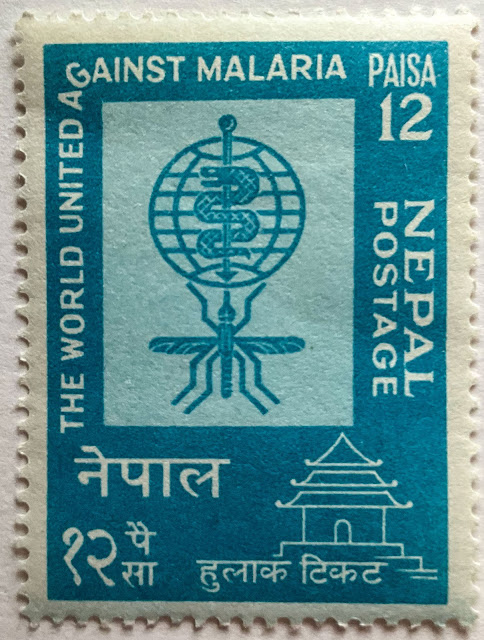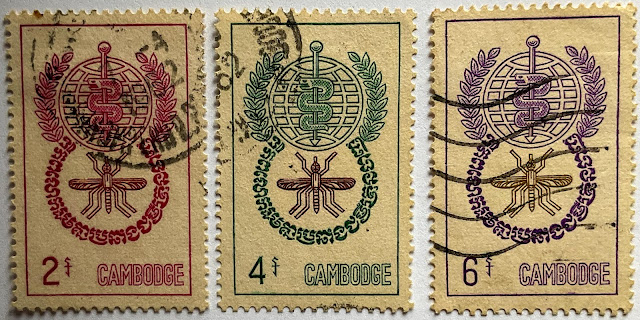This week I continue with the thematic about the 1962 WHO Anti-Malaria Campaign. Our attention now turns to the Asian regions. WHO statistics indicate that Asia ranks second to Africa in terms of its malaria burden. In 19 countries malaria is still endemic and 2.31 billion people or 62% of the population are at risk. In 2010 it was estimated that some 35 million cases and 45,600 deaths were due to malaria.
This is a First Day Cover from Ceylon (now Sri Lanka) which was issued from Colombo on 7 April 1962 which is World Health Day.The design of the stamp is a stylized version of the WHO logo and shows a lion on top of the logo. The cachet shows the standard WHO logo with a banner reading "Fight Against Malaria" on top and "World Health Day , 7th April 1962" on the bottom.
Here we have a stamp issued by Nepal in 1962 for the WHO Campaign. It shows the WHO logo with an inscription around it reading, "The World United Against Malaria".At the bottom of the stamp is a drawing of a pagoda.
This First Day Cover is from the Republic of China (Taiwan). The stamp shows the standard WHO logo with the inscription beneath it reading, "The World United Against Malaria". There are two post marks; one in Chinese on the stamp and the other in the middle of the cover showing a mosquito with the WHO logo and inscribed with, "Malaria Eradication" and dated 7 April 1962. The cachet is more original than most and shows a sprayer shooting insecticide on to four mosquitos. The cover was issued by the Directorate General of Posts.
This stamp is from the islands of Ryukyus, also known as the Nansei Islands or the Ryuku Arc, a chain of Japanese islands that stretch southwest from Kyushu to Taiwan. They include the islands of Osmi, Tokara, Amami, Okinawa and Sakishima, with Yonaguni being the westermost. The stamp shows the WHO logo but has a temple on top.
From the Republic of Korea (South Korea) we have this souvenir sheet that was issued in 1962 for the WHO Camapaign. The stamp design shows the WHO logo and a mosquito next to it.
This three stamp set is from the Republic of Malaysia. Issued in 1962, the design is simply the standard WHO logo.
Thailand issued these two sets of four stamps each for the WHO Campaign . The upper set shows a Thai temple (Wat) with the WHO logo in its center and the inscription, "Malaria Eradication". The lower set is more amusing..it shows a person fighting off a swarm of mosquitos with a small WHO logo in the top right corner.The inscription here is similar to the other set and reads, "Malaria Eradication " in Thai and English.
The Republic of Indonesia issue this four stamp set for the WHO Campaign. The design on all stamps is simply the standard WHO logo. The inscription on the stamps reads "The World United Against Malaria" in Bahasa.
From India we have a stamp issued before the WHO Campaign..it was issued on 26 January 1955 as part of a larger set commemorating various national accomplishments. It shows a mosquito, the WHO Aesculpis and agricultural land as well as factories...the message undoubtedly was that combatting the disease is a help for national development.
Here we have a three stamp set isssued in 1962 by Cambodia. The design is a simple one, the WHO standard logo.
In contrast to the above, we have this First Day Cover from the Kingdom of Laos. It was issued in Vientiane on 19 July 1962 for the WHO Campaign. The three stamps show; the WHO logo , a young girl and a young boy. The inscription in French reads, "Le Monde Uni Contre le Malaria". There are three post marks on the cover; two are simple ones, while the third is a rather ornate one from the Postal Service (PTT) inscribed "Vientiane Day of Issue". The cachet is also quite ornate and resembles the first stamp in its design.
Afghanistan is the country that has issued most stamps for the WHO anti-malaria campaign. This very attractive set of eleven dual imperforate stamps is an example. The colors are vivid and different and the design shows the WHO logo with the date 1962. They have a background that shows mountains and water in front. To note that French is the foreign language used for the inscription on the stamps, "La Lutte Contre le Paludisme".
Here is the official First Day Cover from India issued by the Indian Posts and Telegraphs for the WHO Campaign. The stamp is a simple one, showing the standard WHO logo.The post mark was from Bombay (Mumbai) on 7 April 1962, which is World Health Day. The cachet is a stylized version of the WHO logo with a mosquito and the inscription, "Eradication of Malaria".
From Pakistan we have this First day Cover issued from Karachi on 7 April 1962, World Health Day. The stamps have different designs with the same theme, a large mosquito next to the WHO logo, with the inscription, "Malaria Eradication\' on both. The post mark shows a mosquito, the date 7th April 1962 and the inscription, "Malaria Eradication Campaign" and Karachi Philatelic Bureau. The cachet is a different one and shows a laboratory vessel with a mosquito and arrows pointing at the insect.The inscription is, "Malaria Eradication Programme" and the Pakistan Post Office.
The last two items are from Viet Nam, both North and South, which is before the country's unification in 1976..
From South Viet Nam are these four stamps issued for the WHO Campaign in 1962. The design shows a man spraying insecticide on a mosquito, with a small WHO logo on the right of the stamp.

















On the last stamp, it looks as if the Vietnamese are going to kill the mosquitoes with a sledge hammer.
ReplyDeleteYes indeed Detlef, it does look like a sledge hammer being wielded against the mosquito, but the Viet Namese told me that it was because they wanted to guarantee killing the insect in case the chemicals did not do the job !
ReplyDelete